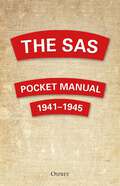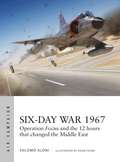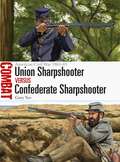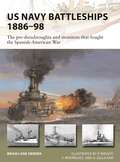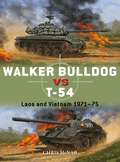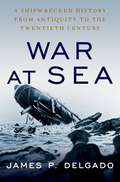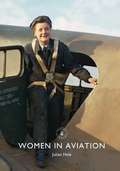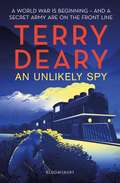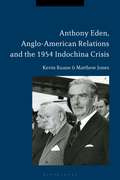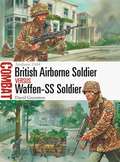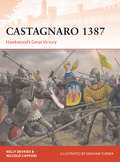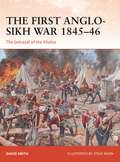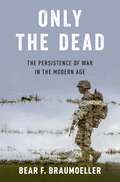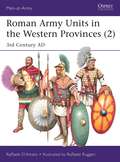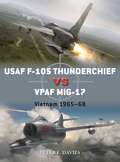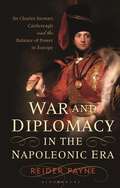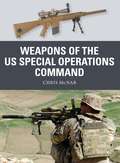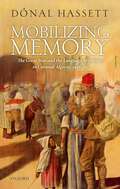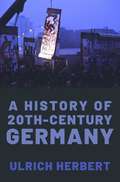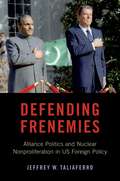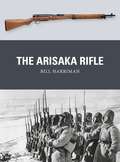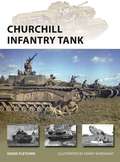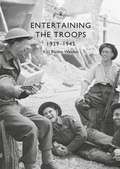- Table View
- List View
The SAS Pocket Manual: 1941-1945
by Christopher WesthorpThe Special Air Service was the brainchild of Scots Guards' officer Lieutenant David Stirling, serving with No 8 Commando. He advocated a specially organised, specially equipped and specially trained unit dedicated to the 'unrelenting pursuit of excellence' that could act covertly and operate behind enemy lines to gain intelligence, destroy enemy aircraft and attack their supply and reinforcement routes.The 1st SAS Regiment was officially designated after successful raids against enemy airfields in the Middle East in 1941-1942. In May 1943 a 2nd SAS Regiment was raised in Algeria and would also serve in Sicily and Italy. SAS troopers were at the forefront of the action on D-Day, serving behind the enemy lines, assisting the French Resistance in diversionary attacks and in support of Allied armies. The SAS served with great distinction through 42 significant actions in Belgium, the Netherlands and Germany until the end of the war in Europe.This new addition to the bestselling Conway pocket-book series is compiled from wartime and post-war memorandums, manuals and documents. They include unit after-action reports and lecture notes from the centres used to train special services soldiers, gathered from the Liddell Hart Military Archive, National Archives, wartime periodicals and post-war memoirs. The book covers: - training methods - weapons handling - fieldcraft - sabotage training - operations in North Africa and the Middle East (1941–1942), Sicily and Italy (1943) and France (1944–1945)
Six-Day War 1967: Operation Focus and the 12 hours that changed the Middle East (Air Campaign)
by Shlomo AloniOn one day in June, the balance of air power in the Middle East was turned upside down by perhaps the most ruthlessly effective air superiority campaign in history – Operation Moked, or Focus. In 1967, the Israeli Air Force was outnumbered more than two to one by the jets of hostile Egypt, Syria, Jordan and Iraq. Operation Focus was Israel's ingenious strike plan to overturn the balance. At 0745hrs on June 6, Israeli jets hit Egypt's airfields simultaneously, first bombing runways and then strafing aircraft. Another 20 follow-up missions were already in the air, initially scheduled to hit every five minutes. This new history of Operation Focus explains how the concept for Focus was devised and meticulously planned, the astonishing rate of serviceability and turnaround speed it required from ground crews, and how the relentless tempo of strikes shattered one air force after another. It is the story of how Israel's victory in the Six-Day War began with a single, shocking day.
Union Sharpshooter vs Confederate Sharpshooter: American Civil War 1861–65 (Combat)
by Gary YeeDuring the American Civil War, the Union and the Confederacy both fielded units of sharpshooters. Sometimes equipped with firearms no better than those of their infantry brethren, they fought in a manner reminiscent of Napoleonic-era light infantry. Siege warfare placed a premium on marksmanship and the sharpshooter became indispensable as they could drive artillerymen from their guns. They could also become expert scouts and, for the Confederacy, impressive raiders – one raid netted almost 250 prisoners. Initially, Union marksmen enjoyed the upper hand, but as the Confederates began raising and training their own sharpshooters, they proved themselves as worthy opponents. In this study, Gary Yee, an expert in firearms of the period, assesses the role played by sharpshooters in three bloody clashes at the height of the American Civil War – the battle of Fredericksburg, the siege of Vicksburg, and the siege of Battery Wagner.
US Navy Battleships 1886–98: The pre-dreadnoughts and monitors that fought the Spanish-American War (New Vanguard)
by Brian Lane HerderAfter the American Civil War, the US Navy had been allowed to decay into complete insignificance, yet the commissioning of the modern Brazilian battleship Riachuelo and poor performance against the contemporary Spanish fleet, forced the US out of its isolationist posture towards battleships. The first true US battleships began with the experimental Maine and Texas, followed by the three-ship Indiana class, and the Iowa class, which incorporated lessons from the previous ships. These initial ships set the enduring US battleship standard of being heavily armed and armoured at the expense of speed. This fully illustrated study examines these first six US battleships, a story of political compromises, clean sheet designs, operational experience, and experimental improvements. These ships directly inspired the creation of an embryonic American military-industrial complex, enabled a permanent outward-looking shift in American foreign policy and laid the foundations of the modern US Navy.
Walker Bulldog vs T-54: Laos and Vietnam 1971–75 (Duel)
by Chris McNabDuring the Vietnam War, both the United States and the Soviet Union supplied all manner of weapon systems to the opposing sides, including tanks and armoured vehicles. Two tanks in particular took momentary prominence in the later years of the conflict. On the South Vietnamese side, it was the US M41 Walker Bulldog; for the communist North Vietnamese, the Soviet-supplied T-54 main battle tank was the core of their armoured power. In their first major engagement, during Operation Lam Son 719 (February–March 1971), it was the Walker Bulldog in the ascendant, but in later battles the T-54s inflicted heavy losses on their lighter opponents, taking the advantage through their superior manoeuvrability and gunnery. Illustrated with full-colour artwork as well as rare and revealing photographs from both sides, this book studies these two iconic tanks in Vietnamese service, examining how their differing designs and fighting doctrines affected their performance in this unique theatre of combat.
War at Sea: A Shipwrecked History from Antiquity to the Twentieth Century
by James P. DelgadoThe ocean is humanity's largest battlefield. Resting in its depths lie the lost ships of war, spanning the totality of human history. Many wrecks are nameless, others from more recent times are remembered, honored even, as are the battles that claimed them, like Actium, Trafalgar, Tsushima, Jutland, Pearl Harbor, and Midway. Underwater exploration is increasingly discovering long-lost warships from the deepest parts of the ocean, revealing a vast undersea museum that speaks to battles won and lost, service, sacrifice, and the human costs of warfare. War at Sea is a dramatic global tour of this remote museum and other formerly lost traces of humanity's naval heritage. It is also an account by the world's leading naval archaeologist of how underwater exploration has discovered these remains, thus resolving mysteries, adding to our understanding of the past, and providing intimate details of the experience of naval warfare. Arranged chronologically, the book begins with the warships and battles of the ancient Egyptians, Phoenicians, Greeks, Romans, and Chinese, and then progresses through three thousand years to the lost ships of the Cold War. James Delgado, who has personally explored, dived, and studied a number of the wrecks and sites in the book, provides insights as an explorer, archaeologist, and storyteller. The result is a unique and compelling history of naval warfare. From fallen triremes and galleons to dreadnoughts, aircraft carriers, and nuclear submarines, this book vividly brings thousands of years of naval warfare to life.
Women in Aviation (Shire Library)
by Julian HaleThis title explores the scope of women's activities in aviation, from the time of the Wright Brothers to the present day. After highlighting the earliest female aviators, as well as the trailblazers of the inter-war period such as Amy Johnson and Amelia Earhart, the book goes on to examine the experience of women in aviation during the Second World War, including those flying with the Air Transport Auxiliary and the American Women Airforce Service Pilots. The post-war years are also covered and the title emphasises the growth in women's participation in civil and military spheres of aviation – by the last decades of the twentieth century, women had progressed even further, undertaking many of the jobs previously reserved for men, including space flight and combat flying. From the earliest women to obtain pilot's licenses to the female astronauts of the modern day, this is a concise introduction to the development of British and American women's roles in aviation.
An Unlikely Spy
by Terry DearyThrilling historical adventure from Terry Deary, the 'outstanding children's non-fiction author of the 20th century' (Books For Keeps)This brand new, exciting adventure from bestselling Horrible Histories author Terry Deary brings the Second World War to life. Perfect for fans of Michael Morpurgo and John Boyne. World War II has begun. Brigit has been evacuated to Wales from her home near the aeroplane factories of Coventry. But when it's revealed that her father is German, Brigit runs away to join her mother in a very special training camp, where Churchill is building a secret army of spies and saboteurs known as the Special Operations Executive.Brigit and her mother soon find themselves on the front line in Nazi-occupied France, where they search for double agents and meet with danger at every turn in their efforts to support the French resistance. But no-one will suspect Brigit is a spy, will they? After all, who would suspect a child?Featuring characters from The Silver Hand, this page-turning adventure sheds new light on the Second World War and will have readers gripped from start to finish.
Anthony Eden, Anglo-American Relations and the 1954 Indochina Crisis
by Kevin Ruane Matthew JonesIn the spring of 1954, after eight years of bitter fighting, the war in Vietnam between the French and the communist-led Vietminh came to a head. With French forces reeling, the United States planned to intervene militarily to shore-up the anti-communist position. Turning to its allies for support, first and foremost Great Britain, the US administration of Dwight D. Eisenhower sought to create what Secretary of State John Foster Dulles called a “united action” coalition. In the event, Winston Churchill's Conservative government refused to back the plan. Fearing that US-led intervention could trigger a wider war in which the United Kingdom would be the first target for Soviet nuclear attack, the British Foreign Secretary, Anthony Eden, was determined to act as Indochina peacemaker – even at the cost of damage to the Anglo-American “special relationship”.In this important study, Kevin Ruane and Matthew Jones revisit a Cold War episode in which British diplomacy played a vital role in settling a crucial question of international war and peace. Eden's diplomatic triumph at the 1954 Geneva Conference on Indochina is often overshadowed by the 1956 Suez Crisis which led to his political downfall. This book, however, recalls an earlier Eden: a skilled and experienced international diplomatist at the height of his powers who may well have prevented a localised Cold War crisis escalating into a general Third World War.
British Airborne Soldier vs Waffen-SS Soldier: Arnhem 1944 (Combat)
by David GreentreeOperation Market Garden was an Allied plan to try and end the war before the end of 1944, and relied on landing airborne troops to secure bridges over the Rhine bridges in the Netherlands. Critical to this plan were the glider troops of Britain's 1st Airlanding Brigade. Short on heavy weapons and not trained in street fighting, the glider troops were meant to secure and defend the Allied perimeter around Arnhem as the parachute brigades fought their way into the city. Facing the airborne forces were understrength Waffen-SS units that were hastily formed into ad hoc battle groups, some supported by armour. The troops on both sides would have their tactical flexibility and powers of endurance tested to the limit in the bitter actions that ensued. Employing first-hand accounts and drawing upon the latest research, David Greentree tells the story of the glider troops' dogged defence of the Allied perimeter at Arnhem, and the Waffen-SS forces' efforts to overcome them.
Castagnaro 1387: Hawkwood’s Great Victory (Campaign)
by Kelly DeVries Niccolò CapponiThe battle of Castagnaro, fought on 11 March 1387 between the Veronese and the Paduans, is one of the most famous Italian medieval conflicts in the English-speaking world. This is thanks in no small part to the exploits of the renowned English mercenary (or condottiero) captain, Sir John Hawkwood. Commanding the Paduan army, he led them to a stunning victory.This new study challenges the conventional story of the battle, relocating it to the other side of the Adige River, and showing that Hawkwood was no mere disciple of his previous commander, the Black Prince–he was a highly talented and intelligent general in his own right. Using specially commissioned full-colour artwork, this fascinating book shows how Hawkwood used his own acumen, and the training, skills, and discipline of his very experienced condottieri, to defeat his opponents at Castagnaro.
The First Anglo-Sikh War 1845–46: The betrayal of the Khalsa (Campaign)
by David SmithThe First Anglo-Sikh War broke out due to escalating tensions between the Sikh Empire and the British East India Company in the Punjab region of India in the mid-nineteenth century. Political machinations were at the heart of the conflict, with Sikh rulers fearing the growing power of their own army, while several prominent Sikh generals actively collaborated with the East India Company.The British faced a disciplined opponent, trained along European lines, which fielded armies numbering in the tens of thousands. The war featured a number of closely contested battles, with both sides taking heavy losses. This fully illustrated study of the First Anglo-Sikh War tells the story of one of the major colonial wars of the nineteenth century, as the East India Company attempted to wrest control of the Punjab region from a Sikh Empire riven by infighting.
Only the Dead: The Persistence of War in the Modern Age
by Bear F. BraumoellerThe idea that war is going out of style has become the conventional wisdom in recent years. But in Only the Dead, award-winning author Bear Braumoeller demonstrates that it shouldn't have. With a rare combination of historical expertise, statistical acumen, and accessible prose, Braumoeller shows that the evidence simply doesn't support the decline-of-war thesis propounded by scholars like Steven Pinker. He argues that the key to understanding trends in warfare lies, not in the spread of humanitarian values, but rather in the formation of international orders--sets of expectations about behavior that allow countries to work in concert, as they did in the Concert of Europe and have done in the postwar Western liberal order. With a nod toward the American sociologist Charles Tilly, who argued that "war made the state and the state made war," Braumoeller shows argues that the same is true of international orders: while they reduce conflict within their borders, they can also clash violently with one another, as the Western and communist orders did throughout the Cold War. Both highly readable and rigorous, Only the Dead offers a realistic assessment of humanity's quest to abolish warfare. While pessimists have been too quick to discount the successes of our attempts to reduce international conflict, optimists are prone to put too much faith in human nature. Reality lies somewhere in between: While the aspirations of humankind to govern its behavior with reason and justice have had shocking success in moderating the harsh dictates of realpolitik, the institutions that we have created to prevent war are unlikely to achieve anything like total success--as evidenced by the multitude of conflicts in recent decades. As the old adage advises us, only the dead have seen the end of war.
Roman Army Units in the Western Provinces: 3rd Century AD (Men-at-Arms)
by Raffaele D’AmatoThe appearance of Roman soldiers in the 3rd century AD has long been a matter of debate and uncertainty, largely thanks to the collapse of central control and perpetual civil war between the assassination of Severus Alexander in 235 and the accession of the great Diocletian in 284. During those years no fewer than 51 men were proclaimed as emperors, some lasting only a few days. Despite this apparent chaos, however, the garrisons of the Western Provinces held together, by means of localized organization and the recruitment of 'barbarians' to fill the ranks. They still constituted an army in being when Diocletian took over and began the widespread reforms that rebuilt the Empire – though an Empire that their forefathers would hardly have recognized. Fully illustrated with specially chosen colour plates, this book reveals the uniforms, equipment and deployments of Roman soldiers in the most chaotic years of the Empire.
USAF F-105 Thunderchief vs VPAF MiG-17: Vietnam 1965–68 (Duel)
by Peter E. DaviesThe F-105D Thunderchief was originally designed as a low-altitude nuclear strike aircraft, but the outbreak of the Vietnam War led to it being used instead as the USAF's primary conventional striker against the exceptionally well-defended targets in North Vietnam and Laos. F-105 crews conducted long-distance missions from bases in Thailand, refuelling in flight several times and carrying heavy external bombloads.The MiG-17 was the lightweight, highly manoeuvrable defending fighter it encountered most often in 1965–68 during Operation Rolling Thunder. A development of the MiG-15, which shocked UN forces during the Korean War, its emphasis was on simplicity and ease of maintenance in potentially primitive conditions.Fully illustrated with stunning artwork, this book shows how these two aircraft, totally different in design and purpose, fought in a series of duels that cost both sides dearly.
War and Diplomacy in the Napoleonic Era: Sir Charles Stewart, Castlereagh and the Balance of Power in Europe
by Reider PayneThe lives and careers of Sir Charles Stewart and his brother Lord Castlereagh take in a grand stage, from Britain and Ireland to the kingdoms and empires of western and central Europe. Throughout his life Stewart played a key role in shaping Europe: his is a Regency drama beyond anything imagined by Jane Austen: warfare, diplomacy, affairs, royal scandal, a romantic and brilliant marriage, and a brother's suicide. Stewart was at the heart of some of history's greatest events which took him from the bloodiest actions of the Napoleonic Wars to the palaces of Europe's ruling dynasties. For an all too brief period, Stewart blazed across the battlefields and chancelleries of Europe, enjoying a meteoric rise to the highest positions and influence, in a career indelibly linked to his brother's and one which is virtually unique. Stewart even found time to enjoy his share of scandal, from affairs and parties in Vienna to running a spy network which aimed to charge a Princess of Wales with adultery. Reider Payne's book is international in its scope and ambitions: with Stewart's military and diplomatic theatre of operations including Portugal, Spain, Prussia, Saxony, France, Austria and the Austrian territories in Italy. Stewart sat at the heart of the intrigues and social circles of Regency England, and his life story offers an unrivalled viewpoint into the competing claims and demands of Europe's courts.
Weapons of the US Special Operations Command (Weapon)
by Chris McNabThe units and formations of the US Special Operations Command (SOCOM) have privileged access to the finest weaponry in the world's arsenal. Whether Army, Navy, Air Force, or Marines, the SOCOM troops select weapons that match their mission requirements, but which also sit at the cutting edge of combat technology. This means that, while SOCOM troops frequently use standard-issue weaponry, they also adopt many specialist pieces of kit that are not so accessible to the broader armed services, including sniper rifles, battle rifles, and machine guns, as well as high-tech tactical accessories used to transform standard weaponry into something exceptional. Assessing the technology and capabilities of these combat weapons, as well as how they have been used in modern combat, this fully illustrated study lifts the veil on some of the most distinctive hand-held weapon systems of US special operations forces since 1987.
Bomber Boys on Screen: RAF Bomber Command in Film and Television Drama
by S. P. MacKenzieSince the Second World War, depictions of Royal Air Force operations in film and television drama have become so numerous that they make up a genre worthy of scholarly attention. In this illuminating study, S. P. MacKenzie explores the different ways in which the men of RAF Bomber Command have been represented in dramatic form on the big and small screen from the war years to the present day. Bomber Boys on Screen is the first in-depth study of how and why the screen-drama image of those who flew, those who directed them, and those who provided support for RAF bomber operations has changed over time, sometimes in contested circumstances.Until now dramas that focus on Bomber Command have tended to be mentioned only in passing or studied in isolation, despite the prevalence of surveys of both the British war film genre and of aviation cinema. In Bomber Boys on Screen MacKenzie examines the development, presentation, and reception of significant dramas on a decade-by-decade basis. Titles from the beginning of the war (The Lion Has Wings, 1939) to the start of new century (Bomber's Moon, 2014) are situated in the context of technical possibilities and limitations, evolving social and cultural norms in the United Kingdom and elsewhere, and the development of moral and utilitarian controversies surrounding the wartime bomber offensive directed against Nazi Germany. While the focus is on feature films and television plays, reference is also made to documentaries, memorials, veterans' organizations, book titles, war comics, and other representations of the war fought by Bomber Command.
Mobilizing Memory: The Great War and the Language of Politics in Colonial Algeria, 1918-1939
by Dónal HassettOver the course of the Great War, a quarter of million settlers and subjects from Algeria served in French forces. Thousands more crossed the Mediterranean to work in the war industries of metropolitan France. On the Algerian Home Front, men, women, and children of all ethnic, religious, social, and political backgrounds contributed to the imperial war effort. Mobilising Memory is the first study to explore how the mass mobilisation of Algerian society during the First World War transformed politics in the colony. It asks how actors across the colony's racial, ideological, and class divides sought to legitimise their competing visions for Algeria's future by evoking their wartime service. Without diminishing the coercive power of the colonial state, it stresses the agency of the citizens and subjects of Algeria who sought to leverage their contribution to the war to enhance their positions within colonial society. In doing so, Mobilising Memory explores the consequences, often unintended, of framing political, social, and economic demands in a language rooted in the experience of the Great War. It argues that the predominance of this shared political language - grounded in notions of loyalty to and sacrifice for France - meant that most actors in interwar Algeria sought not to break with the Empire but rather to renegotiate their place within it. While these efforts rarely proved successful, the volume demonstrates how they radically reshaped the practice of politics in the colony.
A History of Twentieth-Century Germany
by Ulrich HerbertGermany in the 20th century endured two world wars, a failed democracy, Hitler's dictatorship, the Holocaust, and a country divided for 40 years after World War II. But it has also boasted a strong welfare state, affluence, liberalization and globalization, a successful democracy, and the longest period of peace in European history. A History of Twentieth-Century Germany provides a survey of German history during a century of extremes. Ulrich Herbert sees German history in the 20th century as determined by two contradictory perspectives. On one hand, there are the world wars and great catastrophes that divide the country's history into two parts-before and after 1945. Germany is the birthplace of radical ideologies of the left and right and the only country in which each ideology became the foundation of government. This pattern left its stamp on both the first and second halves of the century. On the other hand, the rise of modern industrial society led to decades of conflict over the social and political order regardless of which political system was in force. Considering these contradictory developments, Herbert tackles the questions of both the collapse in the first half of the century and the development from a post-fascist, ruined society to one of the most stable liberal democracies in the world in the latter half. Herbert's analysis brings together wars and terror, utopia and politics, capitalism and the welfare state, socialism and liberal democratic society, gender and generations, culture and lifestyles, European integration and globalization. The resulting book sets a standard by which historians of the period will be measured in the future.
Defending Frenemies: Alliances, Politics, and Nuclear Nonproliferation in US Foreign Policy
by Jeffrey W. TaliaferroThe United States maintains defense ties with as many as 60 countries, which not only enables its armed forces to maintain command globally and to project its force widely, but also enables its government to exert leverage over allies' foreign policies and military strategies. In Defending Frenemies, Jeffrey W. Taliaferro presents a historical and comparative analysis of how successive US presidential administrations have employed inducements and coercive diplomacy toward Israel, Pakistan, South Korea, and Taiwan over nuclear proliferation. Taliaferro shows that the ultimate goals in each administration, from John F. Kennedy to George H. W. Bush, have been to contain the Soviet Union's influence in the Middle East and South Asia and to enlist China as an ally of convenience against the Soviets in East Asia. Policymakers' inclinations to pursue either accommodative strategies or coercive nonproliferation strategies toward allies have therefore been directly linked to these primary objectives. Defending Frenemies is sharp examination of how regional power dynamics and US domestic politics have shaped the nonproliferation strategies the US has pursued toward vulnerable and often obstreperous allies.
The Arisaka Rifle (Weapon)
by Bill HarrimanEntering service in 1897, the Arisaka family of bolt-action rifles armed Japanese troops and others through two world wars and many other conflicts, including the Russo-Japanese War of 1904–05. Issued in long and short versions – the latter for cavalry and specialists – the Type 30 was the first main Arisaka model, arming Imperial Japan's forces during the Russo-Japanese War, though after the war it was refined into the Type 38, which would still be in use in 1945. The main Arisaka rifle of World War II though was the Type 99. Lighter and more rugged than the US M1903 Springfield rifle it would face in the initial battles in the Pacific, it was produced in four main variants, including a sniping model and a take-down parachutist's rifle. Featuring full-colour artwork as well as archive and close-up photographs, this is the absorbing story of the rifles arming Imperial Japan's forces, from the trenches of Mukden in 1905 to the beaches of Okinawa 40 years later.
Bolt Action: Korea (Bolt Action #29)
by Warlord GamesBeginning in 1950, the Korean War was a defining moment for the UN and the entirety of the early Cold War, widening the already monumental gulf between the east and west, capitalist and communist. This supplement for Bolt Action expands the rules-set from its World War II roots to this new, and truly modern, conflict. Bolt Action: Korea contains all the rules, Theatre Lists, scenarios, and new and exciting units, never seen in Bolt Action before, to wargame this turbulent period of world history.
Churchill Infantry Tank (New Vanguard)
by David FletcherThe NVG covers all seven Marks of Churchill gun tank with variations and the curious self-propelled gun of 1941/42, but not the so-called 'Funnies' or the armoured recovery vehicle variants.It will begin with the prototype tank A20, which has not been covered in any detail before, then go on to look at all seven Marks of Churchill, in particular their different guns. This book will also look at the tank's service in Russia and later with the Irish, Jordanian and Australian Armies. It will also feature on the disastrous Dieppe raid of August 1942, ending with a brief look at the Black Prince or super Churchill which was only developed up to the prototype stage at the end of World War II.The Churchill is an interesting tank, quite different from any other British tank of World War II, built outside the normal process of British tanks and the Department of Tank Design. It was built under the watchful eye of the Prime Minister, after whom it was named, by a firm with no previous experience of tank production. Despite being condemned as unsuitable and more than once being scheduled to be replaced by a better design this never actually happened. It remained in production and ultimately vindicated itself since, although it was slow and noisy it was found to have superior climbing ability and thicker frontal armour than the vaunted German Tiger.Its classification as an Infantry Tank has been extensively criticised although recently one or two authors, notably Americans, seem to have revised their views on this and even Field Marshal Montgomery, who advocated a Universal Tank to fulfil all roles, found the Churchill a useful tank on many occasions, particularly considering its ability to absorb punishment.
Entertaining the Troops: 1939–1945 (Shire Library)
by Kiri Bloom WaldenThis book explores the foundation and work of the Entertainments National Service Association (ENSA) and other entertainment organisations such as CEMA and Stars in Battledress. These organisations ensured that troops in all theatres of the Second World War were visited by big bands, ballet stars, Shakespearian actors and the most famous popular entertainers of the day in order to raise morale. Many of Britain's biggest stars cut their teeth performing on makeshift stages to homesick soldiers, sailors and airmen and women during the war years, with famous performers including Laurence Olivier, Gracie Fields, George Formby, Vera Lynn, Margot Fonteyn and members of The Goons. This book also details the alternative arrangements made when the entertainment organisations couldn't come – the forces often put on their own shows, with pantomimes and plays written and performed by POWs being a prime example.
